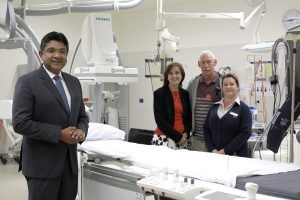
The official launch of a cardiac catheterisation laboratory at Campbelltown Hospital this week means South Western Sydney Local Health District (SWSLHD) remains at the forefront of advanced cardiac technology.
Two interventional suites were delivered as part of stage one in Campbelltown Hospital’s $134 million redevelopment and the lab was the last piece of the jigsaw puzzle.
District cardiovascular clinical stream director associate professor Rohan Rajaratnam said the catheterisation laboratory was a welcomed addition.
“Cardiovascular disease is a common cause of death and the reason for a large proportion of hospitalisations in south western Sydney,” Prof Rajaratnam said.
“Time is of the essence with most cardiac related procedures and the new lab will aid us in providing the best care we can to our patients thanks to two interventional suites.
“These will enable clinicians to use catheters to diagnose and to treat heart and blood vessel conditions,” he said.
The catheterisation lab has diagnostic imaging equipment used to see the arteries and chambers of the heart and treat blockages in a patient’s heart arteries.
[social_quote duplicate=”no” align=”default”]“Catheterisation involves placing a thin tube in an artery or vein in the groin or arm,’’ explained Prof Rajaratnam.[/social_quote]
“It is then threaded through the blood vessels that lead into the heart.
“This procedure is used to diagnose and treat cardiovascular problems,” Prof Rajaratnam said.
By 2021, there will be more than one million people living in South West Sydney, which is why Campbelltown Hospital General Manager Alison Derrett said stage two of the redevelopment will provide many more services that will greatly benefit the community.
“The cardiac catheterisation lab at Campbelltown Hospital is an asset to the community and has had a positive impact on our patients and really puts into perspective the many reasons why we’re expanding alongside the Macarthur population,” Ms Derrett said.
“With so many young families living and relocating to the south west, I’m very pleased that the second round of funding will enable us to provide even more enhancements.”
The cardiac catheterisation laboratory is within the five-storey Acute Services Building, which was part of the stage one redevelopment.
This included 90 inpatient beds, an expansion of the pathology laboratory, 18 new emergency beds and three new birthing suites.
More than $632 million has been committed to Stage two of the hospital’s redevelopment.
